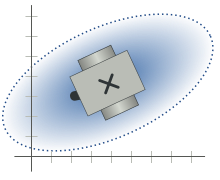Localization (robotics)
Localization (also localization , from the Latin locus : the place) describes in robotics the ability of an autonomous mobile robot to determine its position in its environment. Localization is one of the key points of an autonomous robot's navigation, as it is only on this basis that it can determine the path to its target position. Frequently used approaches to localization are cross-bearing of known landmarks or template matching of the current sensor measurements (also scan matching ).
The exact position of a mobile robot is rarely known. As a rule, an unknown start position or measurement inaccuracies during the movement of the robot cause uncertainty with regard to the position of the robot.
The problem of localization is coupled with the problem of map formation. Without a map of the environment, the robot cannot determine its position in the environment. If neither the position of the robot nor the map of the surroundings are known, one speaks of the simultaneous localization and mapping problem.
Task
The task of locating a robot is to determine its pose in its environment. The pose fully describes the position and orientation of the robot. The task of localization can be divided into two main cases in robotics.
Local localization
Local localization (also position tracking : tracking the position) is the simplest type of localization. With local localization, the current pose of the robot in its environment is known. In the following, when the robot moves, the pose must be continuously updated and checked for correctness using continuous measurements. The movement of the robot is usually estimated using the odometry sensors and the position is corrected accordingly. The task of the local localization is to correct the incremental errors of the odometry sensors. Without this correction, small errors in the odometry would add up to a large position error with the movement of the robot.
Global localization
With global localization, the current pose of the robot in its environment is not known. In contrast to local localization, no small position errors have to be corrected here; rather, due to the unknown position, the error of the initially estimated position is arbitrarily large. The task is therefore much more difficult than localization.
The robot must determine its position by finding significant environmental features. Once the pose is determined, the robot can continue with localization.
Kidnapped Robot Problem
In addition to the local and global localization is respect robustness of the localization process (Engl .: the Kidnapped robot problem Kidnapped robot ) interesting. The position of the robot is initially known, then the robot is repositioned in its environment without being informed. In this case, the robot must independently determine that the previously successful localization is no longer applicable and global localization must be carried out again. The robot can determine the repositioning, for example, via implausible sensor measurements, i.e. measurements that strongly contradict the previous localization.
The solution to the kidnapped robot problem allows a statement to be made about the robustness of the localization with regard to large position errors and the ability of the robot to find its way again independently after grossly incorrect localization.
Pose representation
The aim and output of the localization is the pose of the robot. Since the pose can have small to large uncertainties depending on the accuracy and quality of the available sensor information, a representation of the pose that can represent these uncertainties and ambiguities is suitable. Often either probability distributions or particle clouds are used for this.

Procedure
There are different approaches to calculate the position of a robot. They are all based on the amalgamation of data supplied by the robot's odometry and other sensors. Common sensors for autonomous robots are ultrasonic sensors or laser scanners.
Scan-Matching With this approach, the robot first estimates its position using the odometry data. He then tries to verify or correct it by determining a position where his sensors would deliver the information he is currently receiving. The actual position is calculated from these two position estimates.
Probabilistic approaches These approaches use probability calculation methods to determine a probability distribution over all possible positions where the robot can be.
Particle filter
Particle filters (also Monte Carlo localization or sequential Monte Carlo method ) allow the solution of all three localization problems. Simple implementations allow local and global localization using particle filters, and the kidnapped robot problem can also be solved with a few extensions to the method.
In the solution using particle filters, the pose of the robot is represented by a particle cloud. Each particle represents a possible pose for the robot. Each particle, i.e. each pose represented by it, is checked for plausibility via the particle filter. The probability of plausible particles is increased, the probability of less plausible particles is reduced. If particles fall below a certain probability threshold, they are discarded.
Sensors
Sensor technology, which is used for the localization of robots, can be divided into three categories with regard to the application:
- Measurement of proper movement
- Odometry sensors and compass .
- Measure the distance to landmarks
- Distance measurement to distinguishable objects in the environment, for example using ultrasonic sensors , laser scanners or cameras.
- Measurement of the absolute pose
- Measurement of the pose in global coordinates using, for example, GPS receivers, comparable indoor sensors or radio beacons.
literature
- Juan D. Tardós, Jose A. Castellanos: Mobile Robot Localization and Map Building . A multisensor fusion approach. Springer, Boston 2000, ISBN 978-0-7923-7789-4 .
- Sebastian Thrun , Wolfram Burgard , Dieter Fox : Probabilistic Robotics (Intelligent Robotics and Autonomous Agents) . The Mit Press, Cambridge 2005, ISBN 978-0-262-20162-9 .
Individual evidence
- ↑ Dieter Fox, Sebastian Thrun, Wolfram Burgard and Frank Dellaert: Particle Filters for Mobile Robot Localization . 1998.
